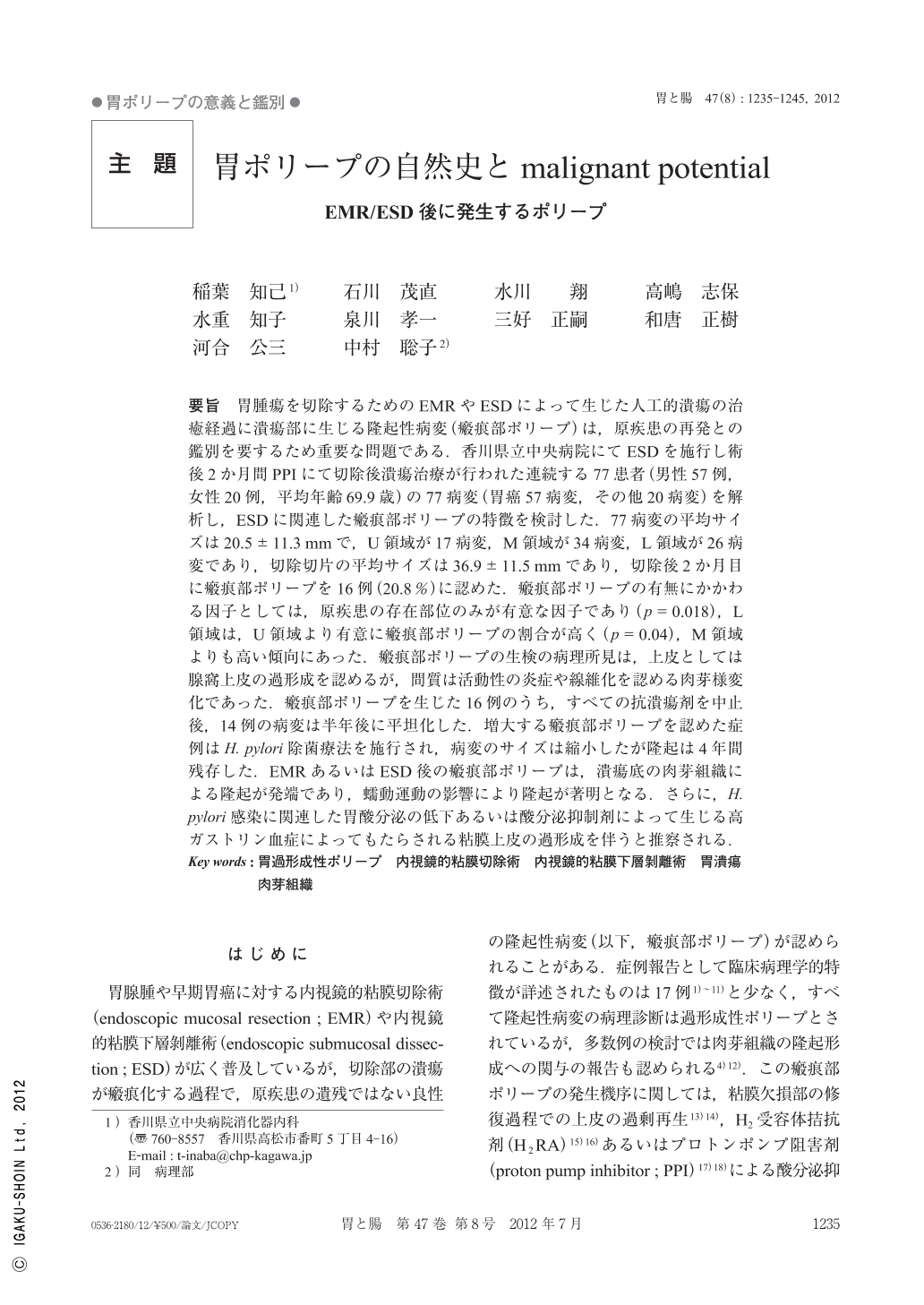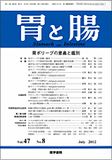Japanese
English
- 有料閲覧
- Abstract 文献概要
- 1ページ目 Look Inside
- 参考文献 Reference
要旨 胃腫瘍を切除するためのEMRやESDによって生じた人工的潰瘍の治癒経過に潰瘍部に生じる隆起性病変(瘢痕部ポリープ)は,原疾患の再発との鑑別を要するため重要な問題である.香川県立中央病院にてESDを施行し術後2か月間PPIにて切除後潰瘍治療が行われた連続する77患者(男性57例,女性20例,平均年齢69.9歳)の77病変(胃癌57病変,その他20病変)を解析し,ESDに関連した瘢痕部ポリープの特徴を検討した.77病変の平均サイズは20.5±11.3mmで,U領域が17病変,M領域が34病変,L領域が26病変であり,切除切片の平均サイズは36.9±11.5mmであり,切除後2か月目に瘢痕部ポリープを16例(20.8%)に認めた.瘢痕部ポリープの有無にかかわる因子としては,原疾患の存在部位のみが有意な因子であり(p=0.018),L領域は,U領域より有意に瘢痕部ポリープの割合が高く(p=0.04),M領域よりも高い傾向にあった.瘢痕部ポリープの生検の病理所見は,上皮としては腺窩上皮の過形成を認めるが,間質は活動性の炎症や線維化を認める肉芽様変化であった.瘢痕部ポリープを生じた16例のうち,すべての抗潰瘍剤を中止後,14例の病変は半年後に平坦化した.増大する瘢痕部ポリープを認めた症例はH. pylori除菌療法を施行され,病変のサイズは縮小したが隆起は4年間残存した.EMRあるいはESD後の瘢痕部ポリープは,潰瘍底の肉芽組織による隆起が発端であり,蠕動運動の影響により隆起が著明となる.さらに,H. pylori感染に関連した胃酸分泌の低下あるいは酸分泌抑制剤によって生じる高ガストリン血症によってもたらされる粘膜上皮の過形成を伴うと推察される.
EMR(endoscopic mucosal resection)or ESD(endoscopic submucosal dissection)for the resection of gastric tumors causes ulcers. It is important to differentiate a protruded lesion that occurs at the site of such artificial ulcers during the healing process(from now on referred to as “cicatricial polyp”)from recurrence of the primary disease. We investigated the characteristics of ESD-related cicatricial polyps by analyzing 77 lesions(57 gastric cancer lesions and 20 other lesions)in 77 consecutive patients(57 men and 20 women ; mean age, 69.9 years)who were treated for an ulcer with a proton pump inhibitor for 2 months after ESD at Kagawa Prefectural Central Hospital. The mean size of the 77 lesions was 20.5±11.3mm. There were 17 lesions in the U area, 34 in the M area, and 26 in the L area. The mean size of the resected specimen was 36.9±11.5mm. Cicatricial polyps were detected in 16 patients(20.8%)2 months after ESD. With regard to the presence or absence of cicatricial polyps, only the site of the primary disease was a significant factor(p=0.018). The frequency of polyps in the L area was significantly higher than that in the C area(p=0.04)and tended to be higher than that in the M area. The pathological findings in biopsies of the cicatricial polyps revealed hyperplastic foveolar epithelia and stroma with granulomatous change showing active inflammation and fibrosis. In 14 of the 16 patients with cicatricial polyps, the lesions became flat in 6 months after the discontinuation of all antiulcer drugs. The patient with a growing cicatricial polyp underwent Helicobacter pylori eradication therapy. Although the size of the lesion was reduced, protrusion persisted for 4 years. The cicatricial polyp after EMR or ESD appears to originate from granulomatous protrusion at the base of an ulcer, which becomes apparent due to the effect of peristaltic movement. It is speculated that the polyp is associated with hyperplasia of the mucosal epithelia due to hypergastrinemia caused by reduced gastric acid secretion associated with H. pylori infection or acid secretion inhibitors.

Copyright © 2012, Igaku-Shoin Ltd. All rights reserved.


